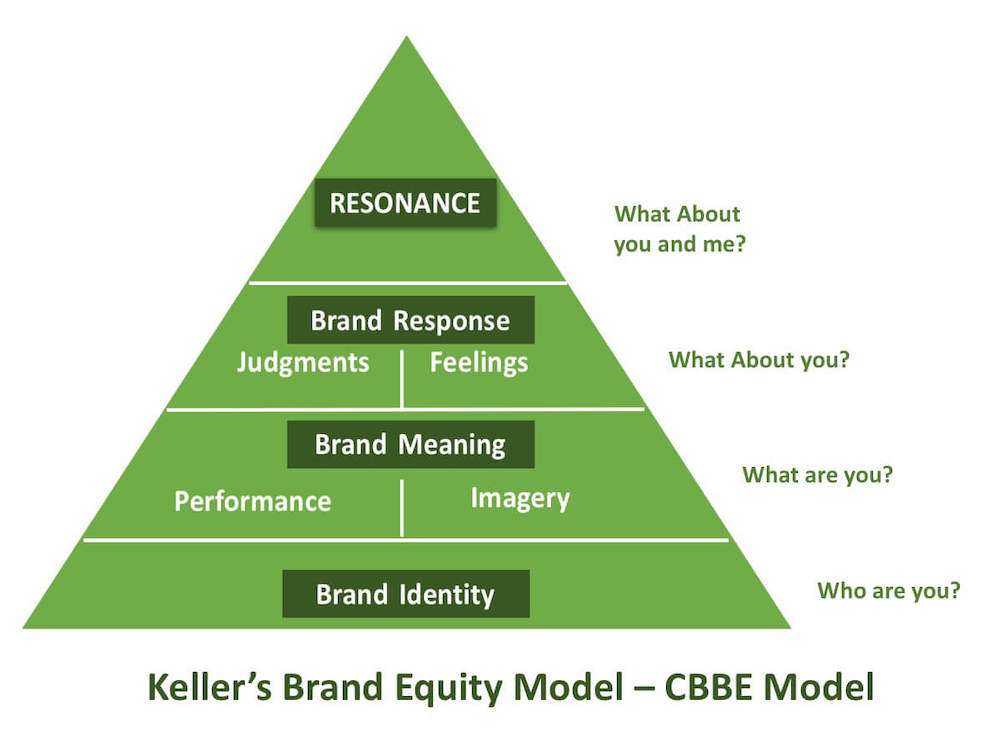Brand equity is a term used to describe the value of having a recognised brand, based on the idea that firmly established and reputable brands are more successful. More specifically, it’s a set of brand assets and liabilities linked to a brand name and symbol, which add to or subtract from the value provided by a product or service.
Connecting “brand” to the concepts of “equity” and “assets” radically changed the marketing function, enabling it to expand beyond strategic tactics and get a seat at the executive table.
Why Is Brand Equity So Valuable?
Another aspect of the definition of brand equity is the argument that brand equity also provides value to customers. It enhances the customer’s ability to interpret and process information, improves confidence in the purchase decision and affects the quality of the user experience. It is argued that cognitive dissonance, a consumer’s need for product reassurance, is satiated once the brand value is established.
The fact that it provides value to customers makes it easier to justify a brand-building budget. This model provides one perspective of brand equity as one of the major components of modern marketing alongside the marketing concept, hyper-personalisation and individualisation rather than personalisation.
Keller’s Customer-Based Brand Equity (CBBE) model
The best-known CBBE model is the Keller Model, devised by Professor of Marketing Kevin Lane Keller and published in his mighty Strategic Brand Management.
With the evolution of marketing, the focus of companies switched to the customer. Happy customers mean profit. Companies realised that to become even more profitable they had to go beyond simply keeping customers happy and build a strong relationship and resonance with them too. Relationships are, of course, built on strong foundations and develop over some time.
Keller’s model is a pyramid. The stages of brand equity move upwards towards the apex and the simple brilliance of this model is that it’s easy to tell what stage the brand is at and what it needs to do to move higher.

Level 1: Brand identity (who are you?)
This is how customers look at your brand and distinguish it from others. It’s the most important stage and must be strong to support the rest of the pyramid above it. Brand identity builds when customers start unaware of your products and values, and then you can attract them with ad campaigns and targeted marketing that increase awareness.
Level 2: Brand meaning (what are you?)
When customers become aware of your brand, they’ll want to know more about it. Do its features work well? Is it reliable? Does it look good? Is the customer service good? Is it value for money? This is brand meaning and is divided into two:
- Brand performance: when a brand ‘does what it says’ and performs well over time, it will be loved and trusted (e.g. Miele, Apple, Microsoft, Virgin)
- Brand imagery: what does the brand appear to be to customers? Land Rover must appear rugged, but Kleenex must appear soft, and this messaging must come out in targeted marketing
Level 3: Brand response (what are the feelings for the brand?)
Once a customer has bought the brand, does it live up to the hype and expectations for them? If they love the product, they have feelings for it, and they’ll tell friends, family and social media to buy one. They are starting to become a brand advocate. If they’re disappointed with their purchase, their judgment of it will be negative and they won’t buy another one and may criticise it widely. They become a brand detractor. Companies need to address judgments and build positive feelings at Level 3.
Level 4: Brand resonance (that strong relationship)
When customers love a brand so much they would not consider buying another one, feel a relationship with it and have a connection with other buyers, they are that very rare and precious thing: a brand advocate. Harley-Davidson is a powerful example of this: two Harley bikers in a parking lot may be strangers, yet instantly feel a connection and have something to talk about. And they would never consider buying another bike brand.

The way up to the resonance level affords a brand the opportunity to recognise and capitalise on its customers’ loyalties and attitudes – both positive and negative. By dividing CBBE into Keller’s four levels, marketers can understand what their customers want and need before they’ve even bought the product, or maybe even before they know they want it.
The iPad is a stunning example of this CBBE: from the robust foundation of Apple’s brand identity, the iPad was developed to look great, be easy to use, do everything its customers wanted, and more. Customers loved it and any glitches that attracted negative responses were quickly patched. Before long, iPad users were extolling its virtues and their loyalty, and the iPad is now ubiquitous in stores, health centres, schools, offices and homes. It’s a classic example of something we didn’t know we needed or wanted until we saw one. Now we can’t do without it.
Aaker’s Brand Equity Model
Whereas the Keller brand equity model focuses largely on emotions, Professor David Aaker says it’s much simpler than that: it’s all about recognition. The most successful brands are those that drive recognition (think Mickey Mouse for Disney) in the emotional part of the brain that makes split-second decisions about what to buy.
Aaker sees brand equity as a mixture of brand awareness, brand associations and brand loyalty. All these add up to the value provided by a brand’s goods or services. The Aaker Model helps to create a brand strategy made up of various components that separate a brand from its competition and advance it.
Aaker says that there are five components of controlling brand equity. The higher the data scores for these, the closer the product is to achieving brand equity:
- Brand awareness: how known is the brand to the public? Like the Keller model, this is the starting point of building brand equity.
- Brand loyalty: how loyal are people to the brand? Loyalty is hard for competitors to copy, so it gives a brand time to respond to competition.
- Perceived quality: is the brand known or expected to deliver good quality products? Quality above features will give a product the edge with consumers – for a while until they begin to demand the features.
- Brand associations: what do people feel when they see the brand? The cognitive, split-second reaction to seeing the brand on adverts, during the buying process, the ‘feel-good factor’, the number of available brand extensions and differentiations.
- Patents, IP and trading partners: brands with higher accumulated proprietary rights have a competitive edge against other brands.
All these components are measurable when run through the right platforms that highlight where more could be done to attain brand equity. Branding needs to be delivered at every touchpoint along the customer journey to ensure this recognition. Data can then be gathered at various stages of marketing to inform and increase customer brand loyalty and show the distinctiveness of the brand from its competitors.
But it also applies in your marketing now too. Failure to adopt sophisticated means to offer brand-to-customer relevance could equally be a fatal flaw in your efforts if not implemented. Customers and becoming more and more savvy about the effect applications adopted by your peers have on them, and your failure to recognise them as individuals, and cater for them at that level renders your efforts ineffective, and potentially condescending.
Examples of Brand Equity
Positive Brand Equity
Amazon and Apple are classic examples of brands with positive brand equities. Both Amazon and Apple provide consistent customer experiences, are dependable, innovative, and purposeful, and are integral in people’s day-to-day lives, making them indispensable.
They also deliver on their promises to customers— Amazon provides convenience and industry-leading shipping options, while Apple prioritises innovation and sleek design. With all factors combined, these brands boast positive reputations or brand equities.
Negative Brand Equity
When it comes to negative brand equity, Volkswagen is an example that can be learned from. In September 2015, the EPA issued a notice of violation stating that the brand had been falsifying emissions numbers. As the news spread, Volkswagen lost brand equity, since the public no longer viewed the brand as trustworthy, nor as adhering to its promises to be environmentally friendly.
The benefits of Brand Equity
Positive brand equity is hugely valuable for businesses. Once you’ve built it up it should increase customer loyalty recommendations and market share.
1. You can charge a premium for your products
Because brand equity means your business is recognisable reliable and trustworthy many shoppers will pay more for your products. 90% of consumers surveyed say they’re happy to pay extra for products made by a trusted brand. Businesses with a valuable brand are also more likely to build loyalty among consumers and sell more. So higher price tags won’t necessarily affect sales volumes either.
2. A better reputation requires less ad spend
If your ecommerce store has a good reputation people will seek out your brand. They’ll head directly to your store type your name into Google and follow you on social media.
Having a recognised brand name also means your product listings will stand out as consumers browse the likes of Amazon eBay and other retail sites. And Google will probably boost your rankings too. All of this means that ecommerce companies with positive brand equity aren’t reliant on PPC ads or other paid marketing to attract sales.
3. It adds value to your ecommerce company
Positive brand equity can boost a company’s stock price. It also adds to the value of your business if you ever want to sell it. That’s because positive brand equity makes your business more durable and flexible. Thanks to the value of its name you’ll be able to face any difficult circumstances by relying on loyal customers licensing intellectual property or pivoting your product range.





